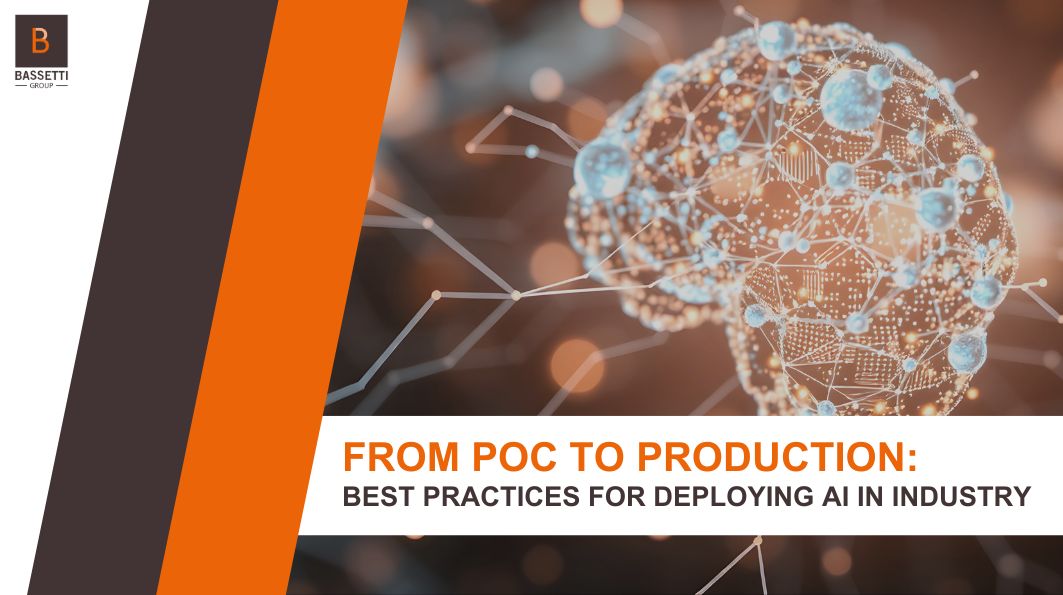From POC to Production: Best Practices for Deploying AI in Industry
Artificial intelligence has matured beyond experimentation. Across industries, proof-of-concept (POC) projects are demonstrating the potential of AI to accelerate innovation, streamline operations, and unlock new forms of value. Yet, for many organizations, turning those promising prototypes into scalable, production-ready systems remains a challenge.
The gap between POC and production isn’t simply technical, it’s organizational, cultural, and strategic. Success requires more than a functional model; it demands integration, governance, and a long-term vision for how AI will coexist with people, processes, and infrastructure.
This article explores how industrial organizations can navigate that transition effectively, moving from experimentation to execution while preserving the agility, transparency, and trust that sustainable AI adoption demands.

1. Clarify the “Why” Before the “How”
Every AI initiative should start with a clear definition of purpose. Many POCs begin with an appealing technology and only later search for a use case, often resulting in fragmented efforts that fail to demonstrate measurable value.
Before developing a single line of code or training a model, organizations should define:
- The problem being solved: why it matters.
- The desired outcomes: efficiency, accuracy, innovation, or resilience.
- The success metrics: how performance will be measured.
Defining the “why” anchors the project in business reality, aligns stakeholders, and ensures that the move from POC to production is not just possible but purposeful.
2. Build the Right Data Foundations
AI thrives on data, but only if that data is accurate, consistent, and accessible. The transition to production often reveals weaknesses in data quality or structure.
Key steps for strong data foundations include:
- Quality control: Detect errors, outliers, and inconsistencies.
- Metadata management: Track data lineage and ensure reproducibility.
- Secure pipelines: Protect sensitive information and maintain compliance.
Industrial environments, in particular, demand an integrated view of data coming from sensors, maintenance logs, ERP systems, and external partners. Creating this unified, trusted “digital backbone” is essential for any production-grade AI.
3. Design for Scalability and Robustness
A successful proof-of-concept might perform well in controlled settings but fail under real-world variability. Production AI must handle:
- Continuous data inflows and operational stress
- Unpredictable input changes and model drift
- Ongoing maintenance and version updates
Best practice: Treat AI as a living system. Build modular architectures with containerized components, automated retraining, and performance monitoring. This reduces technical debt and ensures long-term reliability.
4. Embed AI Within Business Processes
Many AI initiatives struggle not because the models are wrong, but because the workflows around them are. Embedding AI requires a deep understanding of how humans use and trust its outputs.
To integrate effectively:
- Map how decisions are made and where AI can assist.
- Ensure seamless data flow between AI systems and existing tools.
- Define accountability for AI-driven recommendations.
In manufacturing, for example, predictive maintenance algorithms must connect with maintenance planning systems and procurement workflows. Integration is both a technical and organizational exercise.
5. Prioritize Explainability and Trust
As AI influences more critical business functions, transparency becomes essential. Users need to understand why a model makes certain predictions.
Key practices include:
- Using explainable AI (XAI) methods to interpret outputs.
- Maintaining clear documentation for data sources and model updates.
- Enforcing ethical guidelines and compliance frameworks.
In industrial contexts, explainability doesn’t just build trust, it safeguards operations, safety, and regulatory integrity.
6. Start Small, Scale Smart
Scaling AI doesn’t mean expanding rapidly, it means expanding wisely.
A progressive scaling strategy might follow this pattern:
- Pilot: Launch a targeted project that solves a visible problem.
- Validate: Measure impact, ROI, and user feedback.
- Replicate: Extend to similar sites, teams, or use cases.
- Scale: Integrate into enterprise systems and governance.
Each iteration refines both the technology and the organizational maturity around it.
7. Foster Cross-Functional Collaboration
Successful AI deployment requires cooperation between:
- Data scientists who develop models.
- IT teams who ensure infrastructure and security.
- Domain experts who interpret results and contextualize insights.
Involving subject-matter experts early prevents misalignment between AI output and real-world decision-making. This interdisciplinary collaboration transforms AI from a technical project into a shared business capability.
8. Prepare People for Change
Even the best-designed AI system fails without human adoption. Resistance often stems from uncertainty about how automation will affect roles and responsibilities.
To foster acceptance:
- Communicate the purpose and benefits of AI clearly.
- Involve employees in testing and feedback loops.
- Offer training programs that enhance digital literacy.
When employees see AI as a partner rather than a threat, organizations unlock new levels of efficiency and innovation.
9. Implement Continuous Monitoring and Improvement
The journey doesn’t end at deployment. AI systems must evolve alongside data, processes, and market conditions.
Continuous improvement involves:
- Monitoring model drift and performance degradation.
- Setting up alert systems for anomalies or biases.
- Regularly retraining and validating models with fresh data.
Periodic review meetings between AI teams and domain experts ensure that the system remains aligned with strategic goals.
10. Partner Strategically for Sustainable Success
Few organizations can master every aspect of AI deployment internally. Partnering with experienced specialists accelerates adoption and ensures long-term stability.
The right partner can help:
- Assess readiness and design AI roadmaps.
- Build ethical, transparent governance frameworks.
- Manage the full lifecycle from audit to adoption.
By leveraging tailored AI services that combine human insight with technical excellence, companies can transform industrial challenges into lasting opportunities.
A Partner for Deploying AI
Bassetti AI Services is more than a provider, it’s a trusted partner. The goal is clear: turn AI’s promises into tangible results that combine efficiency, innovation, and human value.
AI is the tool. Humans remain the driving force.
Interested in exploring how AI could transform your business processes? Contact Bassetti AI Services to start the conversation.
Turning Potential into Performance
Moving from POC to production is the decisive moment in every AI journey. It’s where innovation meets execution, and where the true value of artificial intelligence is realized.
For industrial organizations, the challenge lies not in building AI that works in the lab, but in building AI that works at scale, under real conditions, in harmony with human expertise. That requires vision, discipline, and collaboration across every level of the enterprise.
The best practices outlined here, from data governance to explainability, from cross-functional teamwork to continuous improvement, form the blueprint for sustainable AI deployment.
When organizations combine technological strength with human insight, AI ceases to be an experimental tool and becomes a catalyst for transformation: a bridge between today’s operations and tomorrow’s intelligent enterprise.
